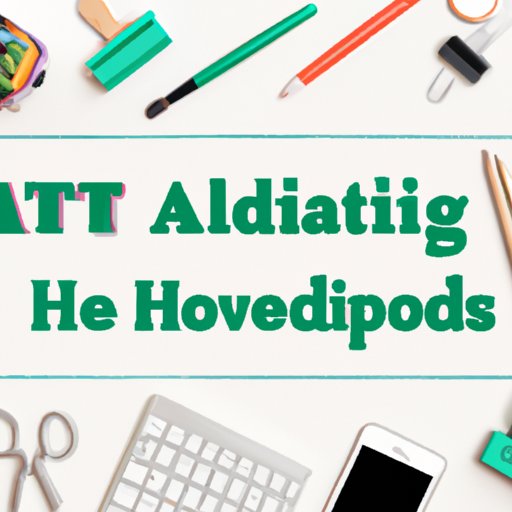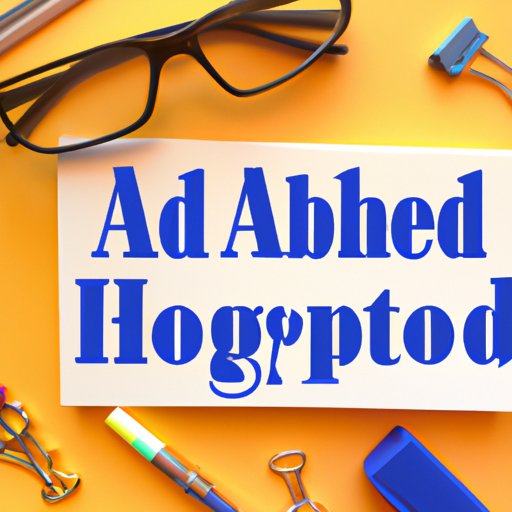I. Introduction
Attention-Deficit/Hyperactivity Disorder (ADHD) is a neurodevelopmental disorder that affects both children and adults. It is characterized by symptoms such as hyperactivity, impulsivity, and difficulty staying focused. ADHD can impact various aspects of life, including school, work, and relationships. However, managing ADHD is possible and can lead to improved productivity, self-esteem, and overall quality of life.
In this article, we will discuss various tips, techniques, and tools that can help individuals with ADHD manage their symptoms, reduce distractions, and stay organized. We will also delve into the importance of building a support network, making lifestyle changes, and coping with ADHD in the workplace and as an adult.
II. Tips and Tricks for Managing ADHD
Individuals with ADHD often struggle with staying organized and focused. However, implementing certain tips and tricks can help manage symptoms and improve productivity. Some of the most effective strategies include:
Importance of routines and schedules
Creating a daily routine and sticking to a schedule can help individuals with ADHD stay on track and avoid distractions. The routine should include important tasks, such as work or school responsibilities, as well as self-care activities, such as exercise and relaxation. Scheduling breaks throughout the day can also help maintain focus and reduce restlessness.
Break down tasks into smaller, manageable steps
Breaking down larger tasks into smaller, more manageable steps can make them feel less overwhelming. It can also help individuals with ADHD stay motivated and avoid procrastination. Using a task management system, such as a to-do list or a task-tracking app, can help keep track of completed and pending tasks.
Reduce distractions in your environment
ADHD symptoms can be exacerbated by distractions in one’s environment. Reducing or eliminating these distractions can help individuals with ADHD stay focused and organized. Examples of distractions include loud noise, clutter, and visual stimuli. Reducing or eliminating these environmental factors can help individuals with ADHD reduce overwhelm and better focus on tasks at hand.
Use positive reinforcement to stay motivated
Positive reinforcement involves rewarding oneself for completing a task or achieving a goal. For individuals with ADHD, this can help maintain motivation and improve focus. The reward can be something as simple as watching a favorite show or going for a walk. Celebrating small victories can help build momentum and create positive habits.
III. Simple yet Efficient Techniques for Dealing with ADHD Symptoms
In addition to managing symptoms through routines and positive reinforcement, various simple yet effective techniques can help individuals with ADHD reduce anxiety, hyperactivity, and impulsivity. Some of these techniques include:
Mindfulness and meditation
Mindfulness and meditation techniques involve focusing on one’s breath or present moment awareness. These techniques have been shown to improve attention and reduce hyperactivity and impulsivity. Regular mindfulness practice can improve overall emotional well-being and provide relief for ADHD sufferers.
Deep breathing exercises
Deep breathing exercises can help individuals with ADHD reduce feelings of overwhelm and stress. It involves focusing on one’s breath and inhaling and exhaling deeply and consistently. This technique can be practiced in any setting, including the workplace.
Journaling
Journaling can be a helpful tool for individuals with ADHD to process their thoughts and feelings. It can be used to track progress, set goals, and release pent-up emotions. Journaling can also provide a sense of clarity and aid in decision-making.
Sensory techniques (fidget toys, weighted blankets)
Sensory techniques, such as using fidget toys or weighted blankets, can provide relief for individuals with ADHD. These techniques help reduce restlessness and increase focus by providing sensory stimulation. Some individuals with ADHD have reported success with using these techniques in various settings, including the workplace.

IV. The Best Tools and Apps to Stay Organized and Productive with ADHD
In today’s digital age, various tools and apps can help individuals with ADHD stay organized and productive. Some of these apps include:
Time management apps
Time management apps can help individuals with ADHD stay on track and avoid procrastination. Some examples of time management apps include “Forest,” which encourages users to stay focused by planting a virtual tree that grows as they work, and “Trello,” which allows users to create virtual boards to track completed and pending tasks.
Calendar apps
Calendar apps can help individuals with ADHD keep track of appointments, meetings, and other important dates. Some popular calendar apps include “Google Calendar,” “Apple Calendar,” and “Outlook.”
Reminder apps
Reminder apps can be used to set and receive reminders for important tasks and deadlines. Some examples of reminder apps include “Todoist” and “Wunderlist.”
Note-taking apps
Note-taking apps allow individuals with ADHD to organize and track ideas, take notes on the go, and create to-do lists. Some popular note-taking apps include “Evernote” and “OneNote.”
V. Building a Support Network
Building a support network can be crucial for individuals with ADHD. Having support can help reduce feelings of isolation and provide a sense of community. Some ways to build a support network include:
The importance of seeking help
Seeking help from a trusted friend, family member, or mental health professional can provide much-needed support and guidance. It is important to seek help if symptoms of ADHD become too overwhelming or interfere with daily life.
How to communicate with friends, family, and colleagues
Communicating openly and honestly with friends, family, and colleagues can help reduce misunderstandings and increase understanding of the challenges faced by individuals with ADHD. Sharing information about the condition, symptoms, and strategies for managing symptoms can help create a more supportive environment.
Support groups and therapy for ADHD
Support groups and therapy can provide individuals with ADHD with a safe and supportive space to discuss their experiences and connect with others who face similar challenges. Online support groups and therapy can also be helpful for individuals who are unable to attend in-person sessions due to schedule or transportation limitations.
VI. Lifestyle Changes to Help Reduce ADHD Symptoms
Healthy lifestyle changes can help reduce symptoms of ADHD and improve overall well-being. Some effective lifestyle changes include:
Balanced nutrition
Eating a balanced diet rich in fruits, vegetables, lean protein, and whole grains can help improve focus and reduce hyperactivity. Avoiding sugary and processed foods can also help reduce symptoms of ADHD.
Regular exercise
Regular exercise, such as jogging, swimming, or yoga, can provide relief for individuals with ADHD. Exercise can improve focus, reduce anxiety, and provide an outlet for excess energy.
Proper sleep habits
Getting enough sleep is crucial for individuals with ADHD. Lack of sleep can exacerbate symptoms, including hyperactivity and impulsivity. Establishing a regular sleep routine can help improve sleep quality and reduce symptoms of ADHD.
Reducing screen time
Screen time, including television, video games, and social media, can be overstimulating for individuals with ADHD. Reducing screen time can help reduce hyperactivity and improve focus.
VII. Managing ADHD in the Work Environment
Managing ADHD in the workplace can present unique challenges. However, various strategies can be employed to improve productivity and reduce distractions. Some of these strategies include:
Communicating with your employer about your ADHD
Communicating with one’s employer about their ADHD and any accommodations needed can help create a more supportive workplace environment. Examples of accommodations may include flexible work hours, quiet workspaces, or assistive technology.
Strategies for staying organized and focused at work
Implementing tips and tricks for managing ADHD, such as creating a routine, breaking down tasks, and reducing distractions, can help individuals with ADHD stay focused and productive at work.
Accommodations that can be made
Accommodations, such as flexible work hours or assistive technology, can be requested through one’s employer or human resources department. These accommodations can help reduce distractions and improve productivity.
VIII. Coping with ADHD as an Adult
ADHD can present unique challenges for adults, including difficulty with maintaining relationships and managing responsibilities. However, various strategies can be employed to manage symptoms and improve overall well-being. These strategies include:
Diagnosis and treatment options
Seeking a proper diagnosis and treatment options, such as medication or therapy, can help individuals with ADHD manage their symptoms and improve overall quality of life.
Self-care techniques for managing symptoms
Implementing self-care techniques, such as mindfulness, exercise, and journaling, can help adults with ADHD reduce stress and increase focus. Building healthy habits, such as maintaining a balanced diet and getting enough sleep, can also improve overall well-being.
Strategies for managing stress and overwhelm
Stress and overwhelm can exacerbate symptoms of ADHD. Implementing stress-management techniques, such as deep breathing and time-management strategies, can help adults with ADHD navigate challenging situations and reduce feelings of overwhelm.
IX. Conclusion
ADHD can present challenges in various aspects of life. However, managing symptoms is possible through implementing various tips, techniques, and tools. Building a support network and making healthy lifestyle changes can also help reduce symptoms and improve overall well-being. Remember that seeking help is crucial, and there are many resources available for individuals with ADHD.
